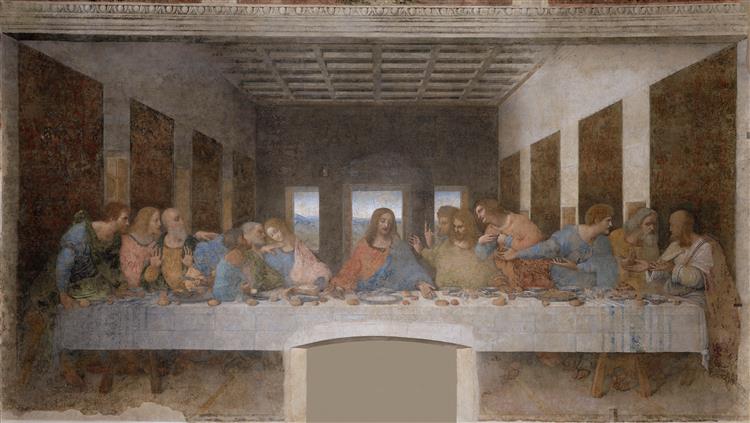The Last Supper
Church Santa Maria delle Grazie, Milan, Italy
Vinci Leonardo da, 1495
One of the most famous paintings in the world, The Last Supper by Leonardo da Vinci was painted in the late 15th century for the Dominican monastery Santa Maria delle Grazie in Milan. The wall painting was commissioned by the Duke of Milan, Ludovico Sforza, who was Leonardo’s patron during his first extended stay in Milan.The composition of The Last Supper is neatly arranged - Jesus is positioned in the center of a long table and the Apostles are to his left and right. The room is relatively plain: dark tapestries cover the walls on either side, while three windows on the back wall reveal a landscape that recalls the countryside of Milan. Leonardo created the illusion of space by using linear perspective – a technique in which all parallel lines in the painting converge in a single vanishing point. In The Last Supper, the single vanishing point, at Jesus’s right temple, draws the viewer’s attention to the main subject in the foreground. Jesus adorns the traditional blue and red robes, but he has no halo. Some scholars have suggested that Leonardo alludes to the halo through the shining light from the window behind Jesus, or the pediment above the window. Others however believed that the absence of the halo signifies the fact that Jesus is a still human being, who, as such, will suffer through the pain and death of the Passion.In his depiction of The Last Supper, Leonardo chose to present the scene as a depiction of successive moments: Jesus has declared to the Apostles that one of them will betray him, and the Apostles react to his announcement. The serene expression and posture of Christ stands in contrast to the confused and agitated state of the Apostles. Their reactions and postures vary, adding interest and drama to the composition: on Christ’s left, James the Greater throws his arms out in anger, Thomas gestures to the sky as if to question God’s plan, and Phillip points towards himself wondering could he be the traitor. Some reactions hold additional symbolism: Peter holds a knife behind his back that he will later use to cut off an ear of a soldier attempting to arrest Christ. Judas, who is next to Peter, tightly grips the purse with the reward he received for betraying Jesus with one hand, while he reaches toward a dish with the other. Judas and Jesus reach for the same dish, a reference to the biblical quote: “The one who has dipped his hand into the bowl with me will betray me” (Matthew 26:23).When painting The Last Supper Leonardo used an experimental technique, working with tempera and oil paint. The experimental technique combined with the humidity and the dampness of the location led to the quick deterioration of the painting. Over the centuries, the painting suffered additional damage. Due to its poor condition, the painting underwent a major restoration that began in 1978. The restoration, completed in 1999, proved controversial: many were dissatisfied with the outcome saying that hardly any of Leonardo’s original work is visible. Still, some praised the recovery of many details, like the food on the table and the facial expressions.
